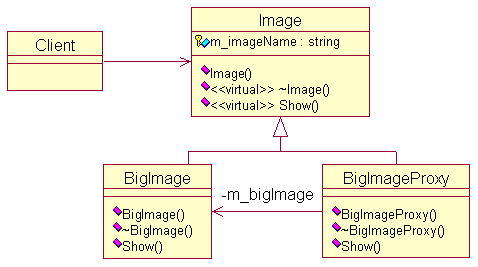设计模式(三) ----代理模式
来源:互联网 发布:pr导出网络视频格式 编辑:程序博客网 时间:2024/04/25 20:23
一,普通代理模式
代理模式也比较容易理解,但是其用途不是很好理解了。

设计模式中运用了面向对象编程语言的重要特性:封装、继承、多态,真正领悟设计模式的精髓是可能一个漫长的过程,需要大量实践经验的积累。-------我还有很长的路要走了。
二 代理模式的使用
为其他对象提供一种代理以控制对这个对象的访问。 其应用场景有:
1 远程代理。
2. 虚拟代理,是根据需要创建开销很大的对象时,通过它来存放实例化需要很长时间的真实对象。这样可以达到性能最优,如当打开html网页时,需要很快打开。但当网页类执行“打开”操作时,遇到图片,就需要等待完成再进行。但是用代理模式,我们可以先保存这样一个图片的代理(存放了,与图片相同大小的尺寸),然后直接预留位置。等文字全部打开,再进行“打开图片”的操作。
其应用中还有auto_ptr。
在这个例子属于虚代理的情况,下面给两个智能引用的例子。一个是C++中的auto_ptr,另一个是smart_ptr。自己实现了一下。先给出auto_ptr的代码实现:
template<class T> class auto_ptr { public: explicit auto_ptr(T *p = 0): pointee(p) {} auto_ptr(auto_ptr<T>& rhs): pointee(rhs.release()) {} ~auto_ptr() { delete pointee; } auto_ptr<T>& operator=(auto_ptr<T>& rhs) { if (this != &rhs) reset(rhs.release()); return *this; } T& operator*() const { return *pointee; } T* operator->() const { return pointee; } T* get() const { return pointee; } T* release() { T *oldPointee = pointee; pointee = 0; return oldPointee; } void reset(T *p = 0) { if (pointee != p) { delete pointee; pointee = p; } } private: T *pointee; }; 3.安全代理,用来控制真实对象访问是的权限。
4.智能引用。
我们知道C++中没有垃圾回收机制,可以通过智能指针来弥补,下面给出智能指针的一种实现,采用了引用计数的策略。
template <typename T>class smart_ptr{public: smart_ptr(T *p = 0): pointee(p), count(new size_t(1)) { } //初始的计数值为1smart_ptr(const smart_ptr &rhs): pointee(rhs.pointee), count(rhs.count) { ++*count; } //拷贝构造函数,计数加1~smart_ptr() { decr_count(); } //析构,计数减1,减到0时进行垃圾回收,即释放空间 smart_ptr& operator= (const smart_ptr& rhs) //重载赋值操作符{//给自身赋值也对,因为如果自身赋值,计数器先减1,再加1,并未发生改变++*count; decr_count(); pointee = rhs.pointee; count = rhs.count; return *this; } //重载箭头操作符和解引用操作符,未提供指针的检查 T *operator->() { return pointee; } const T *operator->() const { return pointee; } T &operator*() { return *pointee; } const T &operator*() const { return *pointee; }size_t get_refcount() { return *count; } //获得引用计数器值private: T *pointee; //实际指针,被代理 size_t *count; //引用计数器void decr_count() //计数器减1{if(--*count == 0) {delete pointee;delete count;}}};以上文章有摘抄,来自http://blog.csdn.net/wuzhekai1985/article/details/6669219
- 设计模式(三) ----代理模式
- 设计模式(三)--代理模式
- java设计模式--代理模式(三)
- 设计模式三 代理模式
- 三.设计模式-代理模式
- 设计模式<三>代理模式
- 设计模式(三)动态代理
- C#设计模式之代理模式(三)
- 设计模式实践(三)代理模式(Proxy)
- 设计模式学习笔记(三)动态代理模式
- 【三】设计模式——代理模式(Proxy Pattern)
- JAVA设计模式(三)静态与动态代理模式
- PHP设计模式系列(三):代理模式
- C#设计模式之代理模式(三)
- 设计模式之代理模式 (三)
- 设计模式之三静态代理模式
- JAVA设计模式之三:代理模式
- Java/Android设计模式<三> 代理模式
- 利用LoadRunner进行http接口功能自动化测试
- Handler sendMessage 与 obtainMessage (sendToTarget)比较
- android工作随笔(第三季)
- java中静态代码块的用法和static用法详解
- java面试题经典20例【第九季_常瑞鹏】
- 设计模式(三) ----代理模式
- Ubuntu下:make menuconfig Error 2('make menuconfig' requires the ncurses libraries)
- OK6410-A编译u-boot时遇到的问题及解决
- wabacus联想输入和自动填充的结合以及回调函数给report赋值
- 如何在Word,excel 中打钩和打叉?
- linux命令整理8:man和其它常用命令
- CRS维护命令总结
- 移动开发中HTML5能否替代本地程序?
- j2EE,J2SE.J2ME的区别


